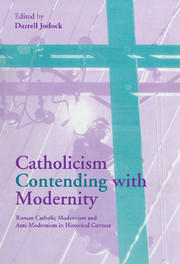 Catholicism Contending with Modernity
Catholicism Contending with Modernity Published online by Cambridge University Press: 30 October 2009
“In a higher world it is otherwise; but here below to live is to change, and to be perfect is to have changed often.” John Henry Newman's celebrated dictum still has the power to startle, coming as it does from a dedicated opponent of liberal Christianity. Newman's conception of Christianity as a “great idea” enabled him to contemplate its interaction with history as a living thing, constantly changing in order to retain its identity. The daring model of Christianity as an “idea,” that is, an impression made upon the imagination, proved incomprehensible to the neo-scholastic mind, which treated the imagination as vastly inferior to the discursive intellect and which saw no reason at all to wrestle with the seemingly intractable problem of how doctrine could preserve its identity as it passed through the cultural vagaries of historical existence. Neo-scholastic ultramontanism saw itself as charged with the custodianship of a fixed and unchangeable deposit; it described the philosophy on which it drew for cognitive self-expression as perennis – that is, valid in and applicable to all ages. The conflict between the concept of Christian doctrines as immutable and perennially valid, on the one hand, and, on the other, as culturally limited expressions of truths which are antecedent to their formulation constitutes the theological core of the Modernist crisis which occurred in the Roman Catholic Church between c. 1890 and 1914.
To save this book to your Kindle, first ensure [email protected] is added to your Approved Personal Document E-mail List under your Personal Document Settings on the Manage Your Content and Devices page of your Amazon account. Then enter the ‘name’ part of your Kindle email address below. Find out more about saving to your Kindle.
Note you can select to save to either the @free.kindle.com or @kindle.com variations. ‘@free.kindle.com’ emails are free but can only be saved to your device when it is connected to wi-fi. ‘@kindle.com’ emails can be delivered even when you are not connected to wi-fi, but note that service fees apply.
Find out more about the Kindle Personal Document Service.
To save content items to your account, please confirm that you agree to abide by our usage policies. If this is the first time you use this feature, you will be asked to authorise Cambridge Core to connect with your account. Find out more about saving content to Dropbox.
To save content items to your account, please confirm that you agree to abide by our usage policies. If this is the first time you use this feature, you will be asked to authorise Cambridge Core to connect with your account. Find out more about saving content to Google Drive.